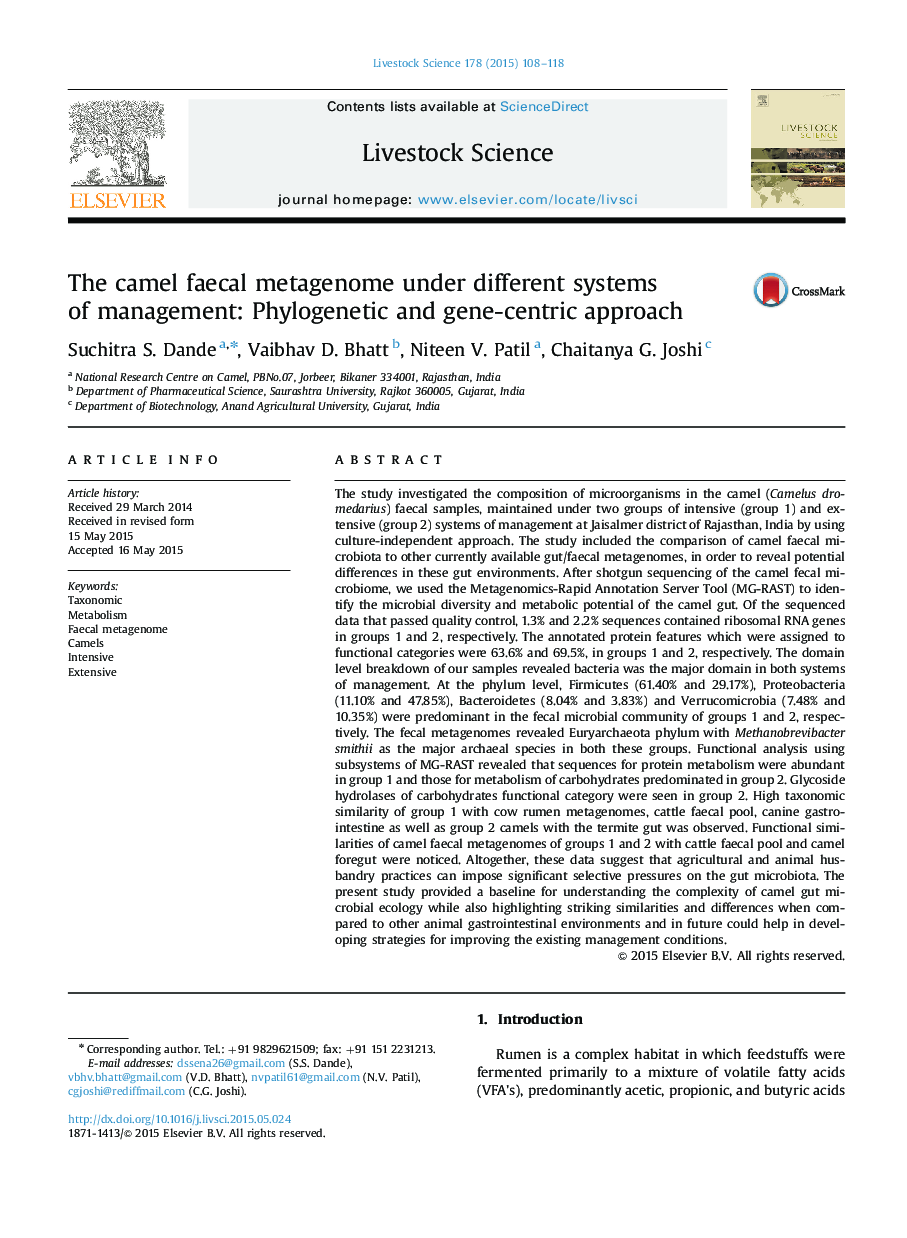| کد مقاله | کد نشریه | سال انتشار | مقاله انگلیسی | نسخه تمام متن |
|---|---|---|---|---|
| 2447067 | 1553954 | 2015 | 11 صفحه PDF | دانلود رایگان |

• Firmicutes (group 1) and Proteobacteria (group 2) are major dominating phyla.
• Protein metabolism (group 1) and carbohydrates (group 2) are major functional categories.
• Universal GTPases (group 2), Ribosome SSU bacterial (group 1) are major genes of protein biosynthesis.
• Glycoside hydrolases predicted functional genes are seen in group 2.
The study investigated the composition of microorganisms in the camel (Camelus dromedarius) faecal samples, maintained under two groups of intensive (group 1) and extensive (group 2) systems of management at Jaisalmer district of Rajasthan, India by using culture-independent approach. The study included the comparison of camel faecal microbiota to other currently available gut/faecal metagenomes, in order to reveal potential differences in these gut environments. After shotgun sequencing of the camel fecal microbiome, we used the Metagenomics-Rapid Annotation Server Tool (MG-RAST) to identify the microbial diversity and metabolic potential of the camel gut. Of the sequenced data that passed quality control, 1.3% and 2.2% sequences contained ribosomal RNA genes in groups 1 and 2, respectively. The annotated protein features which were assigned to functional categories were 63.6% and 69.5%, in groups 1 and 2, respectively. The domain level breakdown of our samples revealed bacteria was the major domain in both systems of management. At the phylum level, Firmicutes (61.40% and 29.17%), Proteobacteria (11.10% and 47.85%), Bacteroidetes (8.04% and 3.83%) and Verrucomicrobia (7.48% and 10.35%) were predominant in the fecal microbial community of groups 1 and 2, respectively. The fecal metagenomes revealed Euryarchaeota phylum with Methanobrevibacter smithii as the major archaeal species in both these groups. Functional analysis using subsystems of MG-RAST revealed that sequences for protein metabolism were abundant in group 1 and those for metabolism of carbohydrates predominated in group 2. Glycoside hydrolases of carbohydrates functional category were seen in group 2. High taxonomic similarity of group 1 with cow rumen metagenomes, cattle faecal pool, canine gastro-intestine as well as group 2 camels with the termite gut was observed. Functional similarities of camel faecal metagenomes of groups 1 and 2 with cattle faecal pool and camel foregut were noticed. Altogether, these data suggest that agricultural and animal husbandry practices can impose significant selective pressures on the gut microbiota. The present study provided a baseline for understanding the complexity of camel gut microbial ecology while also highlighting striking similarities and differences when compared to other animal gastrointestinal environments and in future could help in developing strategies for improving the existing management conditions.
Journal: Livestock Science - Volume 178, August 2015, Pages 108–118